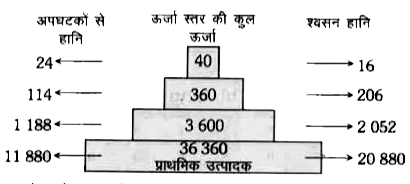Assertion: The loss of biologically useful energy as heat with every energy transfer in a food chain is a consequence of the second law of thermodynamics.
Reason: Energy does not remain trapped permanetly in any organism. It is either passed on to higher trophic level or becomes available to detritivores and decomposers after the organism dies.
The correct Answer is:B
According to second law of thermodynamics, every activity involing energy transformation is accompanied by dissipation of energy. In other words, the loss of biologically useful energy as heat with every energy transfer in a food chain is a consequence of the second law of thermodynamics. Every time energy is transferred from one place to another or transformed from one kind to another, some of it is converted into heat. An organism transfers chemcial energy from to the chemical glucose or fatty acids to ATP (cellular respiration ) and then to the chemical bonds of new molecules (during molecular synthesis), and transforms chemical energy into activ transport of molecules, muscle contractions, and a variety of other activities, which are essential to life. Because every living organism continuously converts chemical energy into heat, there is always a loss of chemical energy with each step in a food chain.
Energy does not remain trapped permanently in any organism. It is either passed on to the higher trophic level or becomes available to detrivores and decomposers after the organism dies. Death of organism is the beginning of the detritus food chain/web.
Topper's Solved these Questions
Similar Questions
State whether the following statement is true or false :
Only 10 per cent of the light energy given by the sun is available for transfer at each higher trophic level in a food chain.
View SolutionFood chains are very important for the survival of most species. When only one element is removed from the food chain it can result in extinction of a species in some cases. The foundation of the food chain consists of primary producers
Primary producers, or autotrophs, can use either solar energy or chemical energy to create complex organic compounds, whereas species at higher trophic levels cannot and so must consume producers or other life that itself consumes producers. Because the sun's light is necessary for photosynthesis, most life could not exist if the sun disappeared. Even so, it has recently been discovered that there are some forms of life, chemotrophs, that appear to gain all their metabolic energy from chemosythesis driven by hydrothermal vents, thus showing that some life may not require solar energy to thrive.

The decomposers are not included in the food chain. The correct reason for the same is because decomposers:
View Solution
Knowledge Check
Assertion: No energy that is trapped into an organism remains in it for ever.
Reason: The energy trapped by the producer is either passed on to a consumer or the organism dies.AIf both assertion and reason are true and the reason is a correct explanation of the assertion.BIf both assertion and reason are true but reason is not a correct explanation of the assertion.CIf assertion is true but reason is false.DIf both assertion and reason are false.What energy percentage can be captured by the organisms of next trophic level
or
transfer of energy from one trophic level is according to second law of thermodynamics. The efficiency of energy transfer from herbivorous to carnivorous isA20%B30%C90%D10%Assertion:- Most of the food chain can be complete with predation.
Reason:- Predation act as condult for energy transfer across trophic levels.AIf both Assertion & Reason are True & the Reason is a correct explanation of the Assertion.BIf both Assertion & Reason are True but Reason is not a correct explanation of the AssertionCIf Assertion is True but the Reason if False.DIf both Assertion & Reason are false.
The length and complexity of food chains vary greatly. Each organism is generally eaten by two or more other kinds of organisms which in turn are eaten by several other organisms. The energy that is captured by the autotrophs does not revert back to the solar input and the energy which passes to the herbivores does not come back to autotrophs. As it moves progressively through the various trophic levels it is no longer available to the previous level.
One of the reasons is the use of several pesticides and other chemicals to protect our crops from diseases and pests. These chemicals are either washed down into the soil or into the water bodies. From the soil, these are absorbed by the plants along with water and minerals, and from the water bodies these are taken up by aquatic plants and animals.
From the information given, figure out what according to you is more appropriate - Food chain or Food web ?
View SolutionAssertion (A) : In a food chain members of successive higher levels are fewer in number.
Reason (R ): Number of organisms at any trophic level depends upon the availability of organisms which serve as food at the lower level.
View SolutionAssertion (A): In any food chain, the number of organisms in any trophic level should always be less than that in its previous trophic level.
Reason (R): Only 10 per cent of total energy present in a trophic level is transferred to the next trophic level in any food chain.
View Solutionदिया गया आरेख ऊर्जा के पिरामिड का है जो खाद्य श्रृंखला से अपघटकों तक ऊर्जा हानि, अगले ऊर्जा स्तर से ऊपर की ओर ऊर्जा के स्थानांतरण तथा श्वसन द्वारा ऊर्जा हानि को दर्शाता है। सभी आरेख kKm−2Y−1 में है

आरेख से स्पष्ट होता है कि
View SolutionAssertion : First law of thermodynamics does not forbid flow of heat from lower temperature to higher temperature.
Reason : Heat supplied to a system always equal to the increase in its internal energy.
View Solution

